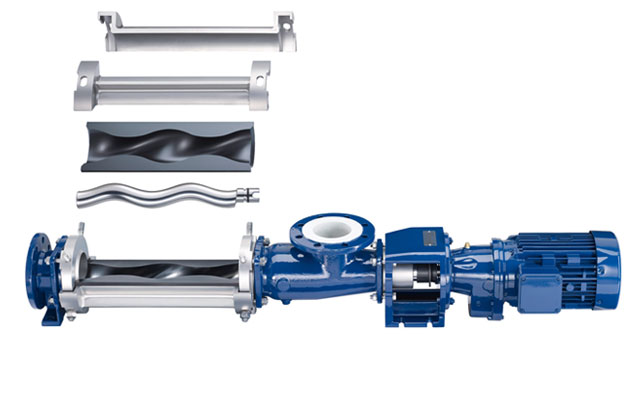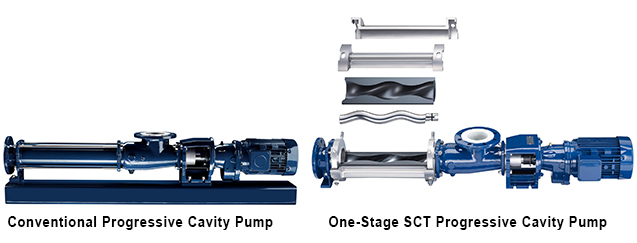Author: Kathryn DeWell, SEEPEX Inc.
Before we discuss Smart Conveying Technology, let’s cover some basics about progressive cavity pumps. A progressive cavity pump is a rotary positive displacement pump that employs a single helix rotor which turns inside a double helix stator to create sealed cavities of fluid or media that progress from the pump’s suction side to the discharge end. Progressive cavity pumps are designed to handle a wide range of viscosities, temperatures, and content which can be comprised of solids and/or gases. These types of pumps, which have existed since the 1930’s, have the capacity to gently convey material with low shear rates and minimal pulsation.
Over the past decade, many pump manufacturers have improved upon the design of existing pumping products. In 2008, SEEPEX introduced to the market a new progressive cavity pump designed with Smart Conveying Technology. The SCT progressive cavity pump, which provides shorter maintenance, reduces downtime, increases parts life, improves energy efficiency and results in overall lower life-cycle costs, is different from conventional progressive cavity pumps in several ways.
Conventional progressive cavity pumps have rubber stators that are chemically bonded inside a metal tube that creates a fixed compression between the rotor and stator. Typically, this conventional configuration requires discharge piping to be removed when replacing the stator. When a maintenance team has to remove the stator and rotor, additional manpower and rigging may be required since the stator must be removed with enough room – often requiring space for double the length of the stator. SCT progressive cavity pumps, however, do not need to be removed from installation for maintenance, nor does the suction or discharge piping need to be removed. An SCT progressive cavity pump does not require any special tools to perform maintenance and it can be worked on by one person – resulting in reductions in maintenance times by up to 85%.
SCT progressive cavity pumps, which include one-stage and two-stage models that handle capacities up to 500 USGPM and pressures up to 120 PSI, allow end users easy access to the pump’s specially engineered stator and rotor. The SCT stator is comprised of two elastomer halves compressed by four metal segments. These segments are easily removed to reveal the progressive cavity pump’s internals for service. This allows pump personnel to perform quick inspection, remove blockages, replace parts, and even increase the flow rate.
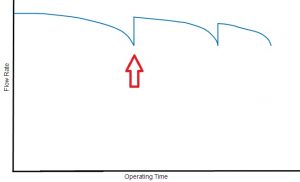 The SCT progressive cavity pump is designed with metal stator segments which can be tightened multiple times to reproduce original flow rates, compensating for normal elastomer wear. In this way, required pressures are achieved, supporting higher energy efficiency and longer parts use. When the SCT progressive cavity pump stator elastomer becomes worn, the adjustment of the segments reproduce original flow rates. At the point indicated, a conventional stator tube would need to be removed. With the correct adjustment, the life of both the SCT progressive cavity pump stator and rotor can be doubled.
The SCT progressive cavity pump is designed with metal stator segments which can be tightened multiple times to reproduce original flow rates, compensating for normal elastomer wear. In this way, required pressures are achieved, supporting higher energy efficiency and longer parts use. When the SCT progressive cavity pump stator elastomer becomes worn, the adjustment of the segments reproduce original flow rates. At the point indicated, a conventional stator tube would need to be removed. With the correct adjustment, the life of both the SCT progressive cavity pump stator and rotor can be doubled.
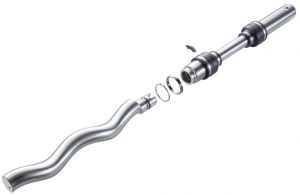 The SCT progressive cavity pump rotor is also specially engineered and manufactured in two pieces: the rotor head and the rotor geometry. This allows the rotor geometry, the portion of the part that wears, to be replaced quickly and without disrupting the universal joint connecting to the power train, saving maintenance time and costs.
The SCT progressive cavity pump rotor is also specially engineered and manufactured in two pieces: the rotor head and the rotor geometry. This allows the rotor geometry, the portion of the part that wears, to be replaced quickly and without disrupting the universal joint connecting to the power train, saving maintenance time and costs.
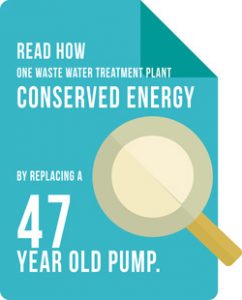 If you are looking for an easy, cost-effective, drop-in solution to replace your older or obsolete pump, consider the SEEPEX SCT progressive cavity pump. SEEPEX is so confident in the SCT design, they are offering a Performance Guarantee that covers free wear parts when you replace a conventional progressive cavity pump with an SCT progressive cavity pump. SCT retrofit of existing SEEPEX standard progressive cavity pumps also qualifies and other pump type replacements can be considered for the guarantee as well. Learn more about the SEEPEX 3-Year SCT Guarantee.
If you are looking for an easy, cost-effective, drop-in solution to replace your older or obsolete pump, consider the SEEPEX SCT progressive cavity pump. SEEPEX is so confident in the SCT design, they are offering a Performance Guarantee that covers free wear parts when you replace a conventional progressive cavity pump with an SCT progressive cavity pump. SCT retrofit of existing SEEPEX standard progressive cavity pumps also qualifies and other pump type replacements can be considered for the guarantee as well. Learn more about the SEEPEX 3-Year SCT Guarantee.
READ HOW ONE WASTE WATER TREATMENT PLANT CONSERVED ENERGY BY REPLACING A 47 YEAR OLD PUMP.
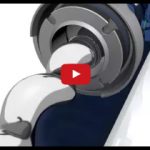 Watch a video of the SCT Progressive Cavity Pump.
Watch a video of the SCT Progressive Cavity Pump.
The SCT design has won several awards, including a 2011 Innovative Technology Award from the Water Environment Federation (WEF) and a 2014 iF Product Design Award for outstanding design quality.
Contact SEEPEX Inc. at sales.us@seepex.com or call 937-864-7150.

